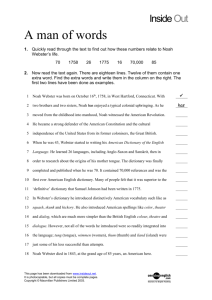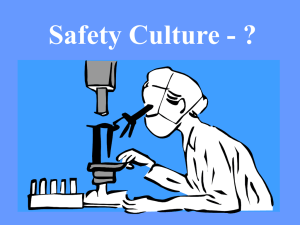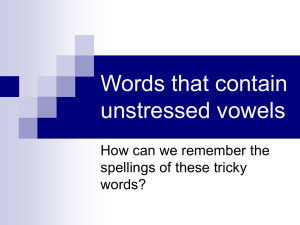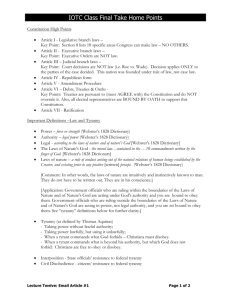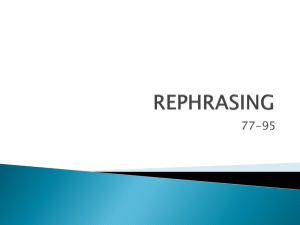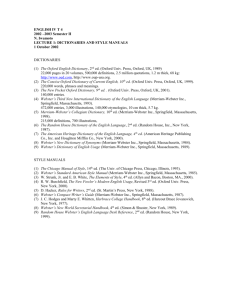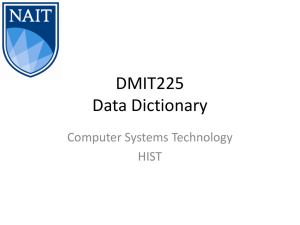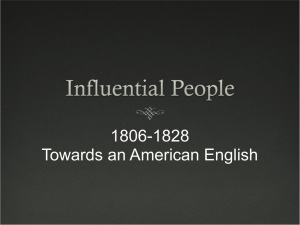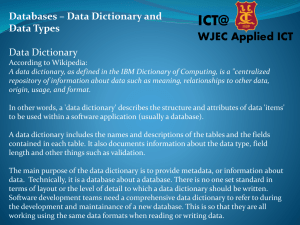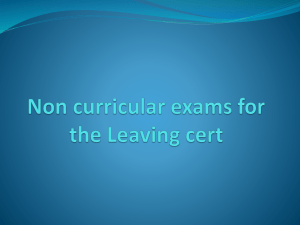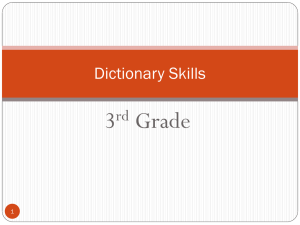Examples
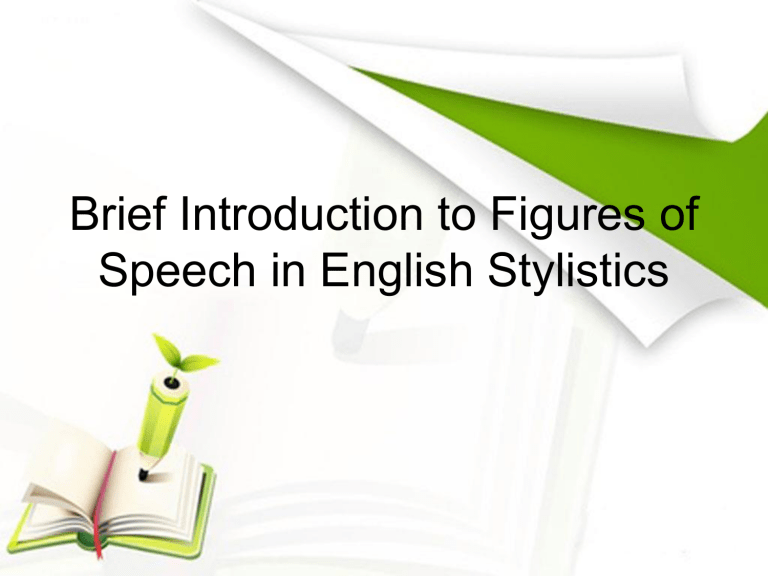
Brief Introduction to Figures of
Speech in English Stylistics
Part One What is Figures of Speech?
Figures of speech ( 修辞 )are ways of making our language figurative. When we use words in other than their ordinary or literal sense to lend force to an idea, to heighten effect, or to create suggestive imagery, we are said to be speaking or writing figuratively.
Part Two Detailed Introduction to Figures of
Speech
Simile
A figure of speech in which one thing is liken to another, in such a way as to clarify and enhance an image. It is an explicit comparison recognizable by the use of the word like or as.
( A Dictionary of Literary Terms)
☺
Comparative words : like, as
☺
Functions : describing shape, scenery; expressing emotions; explaining; vivid description, making easy to understand; creating interest.
Task: Can you figure out the simile rules in the following sentences?
☺
Examples:
My love is like a red red rose.
Marriage is like a beleaguered fortress: those who are without want to get in, and those within want to get out.
Men fear death, as children fear to go in the dark.
What salt is to food, wit and humor are to conversation and literature.
A home without love is no more than a body without a soul.
A word and stone let go cannot be recalled.
A doctor must have the heart of a lion and the hand of a lady.
Metaphor
A figure of speech containing an implied comparison, in which a word or phrase ordinarily and primarily used of one thing is applied to another.
(Webster’s New World Dictionary)
☺
Metaphors are often easy to identify and take the form X is Y.
Something or someone is being compared to something or someone else through a construction using the appropriate part of the verb to be
(i.e. am, are, is, was, were, will be).
Examples:
• Money is a bottomless sea, in which honor, conscience, and truth may be drowned.
• The boy wolfed down the food the moment he grabbed it.
• A policeman waved me out of the snake of traffic.
• Some books are to be tasted, others swallowed, and some few to be chewed and digested. ( Of Studies, Bacon)
Metonymy
A figure of speech that consists in using the name of one thing for that of something else with which it is associated.
(Webster’s New International Dictionary)
Examples:
• She has the eye for the fair and the beautiful.
• What is learned in the cradle is carried to the grave.
• The pen is mightier than the sword.
• China won 4 golds and 5 silvers.
• This is the struggle between the kimono and the miniskirt.
Parody
(Piece of ) writing intended to amuse by imitating the style of writing used by somebody else.
(Oxford Advanced Learner’s Dictionary of
Current English)
Examples:
• I have no outlook, but an uplook. My place in society was at the bottom.
• Where there is a will, there is a lawsuit.
• A husband in hand is worth two in the bush.
• He was born with a Cadillac in his mouth.
• To lie or not to lie—the doctor’s dilemma.
Personification
A figure of speech in which a thing, quality, or idea is represented as a person.
(Webster’s New World Dictionary)
Examples:
• Love, free as air, at sight of human ties, spreads his light wings, and in a moment flies.
• A lie can travel half way around the world while the truth is putting on its shoes.
• Australia is so kind that, just tickle her with a hoe, and she laughs with a harvest.
Onomatopoeia
Combination of sounds in a word that imitating what the word refers to, like ‘hiss’ or ‘boom’.
Examples:
• Murmur, babble, swish, patter, rumble, roll, rustle, zip, toot, tick, tinkle, screech, bang, bubble, clang, crack, splash, grumble
Euphemism
The use of pleasant, mild or indirect words or phrases in place of more accurate or direct ones.
Examples: Examples: Death
• Go west
• At rest
• Asleep
• Return to dust
• Run one’s races
Hyperbole/Overstatement
An exaggerated or extravagant statement used as a figure of speech
(American Heritage Dictionary)
Exaggeration for effect, not meant to be taken literally…
(The Webster’s New World Dictionary)
Extravagant exaggeration
(The Webster’s Ninth New Collegiate Dictionary)
Examples:
• It’s a crime to stay inside on such a beautiful day.
• The most effective water power in the world – women’s tears
• For she was beautiful - her beauty made the bright world dim, and everything beside seemed like the fleeting image of a shade.
- Shelly
Understatement
Statement that expressed an idea, etc, too weakly.
(Advanced Learner’s Dictionary)
Examples:
• The well-known Victorian critique of
Cleopatra's behavior: "So unlike the home life of our own dear Queen!“
• He is a man not without ambition.
• Money is a kind of tight, but I can manage.
Parallelism
The arrangement of a number of related ideas of the same importance in a number of parallel or balanced structures forms a integrated whole, in order to intensify emotion and to emphasize the author’s point.
Examples:
• An Englishman thinks seated; a Frenchman, standing; an American, pacing; an Irishman, afterward.
• Read not to contradict and confuse; nor to believe and take for granted; nor to find talk and discourse; but to weigh and consider.
Contrast
A difference between two or more people or things that you can see clearly when they are compared or put close together; the fact of comparing two or more things in order to show the differences between them.
Examples:
• Men always want to be a woman’s first love; women have more subtle instinct; what they like is to be a man’s last romance.
• Let us never negotiate out of fear, but let us never fear to negotiate.
Antithesis
Contrast of ideas marked by the choice and arrangement of words.
Examples:
• Knowledge make humble, ignorance make proud.
• Life can only be understood backwards, but it must be lived forwards.
• The life of the wolf is the death of the lamb.
Oxymoron
The yoking together of two expressions which are incompatible, so that in combination they have no conceivable literal reference to reality.
Examples:
• It (New York) has the poorest millionaires, the littlest great men, the haughtiest beggars, the plainest beauties, the lowest skyscrapers, the dolefulest pleasures of any town I ever saw.
Pun
An amusing use of a word or phrase that has two meanings, or words with the same sound but different meanings.
Examples:
• To England will I steal, and there I’ll steal.
• We must hang together, or we shall all hang separately.
Zeugma
A figure of speech in which a single word, usually a verb or adjective, is syntactically related to two or more words, with only one of which it seems logically connected.
(Webster’s New World Dictionary of the
American Language)
Examples:
• She opened the door and her heart to the homeless boy.
• She dropped a tear and her pocket handkerchief.
Allusion
An allusion is a figure of speech that makes a reference to, or representation of, people, places, events, literary work, myths, or works of art, either directly or by implication.
Examples:
• The heel of Achilles
─ small but weak or vulnerable point, eg.
In sb’s character
• Tower of Babel
─ tower built to reach heaven
Irony
A method of humorous or subtle sarcastic expression in which the intended meaning of the words used is the direct opposite of their usual sense.
(Webster’s New World Dictionary)
Examples:
• We send missionaries to China so the
Chinese can get to heaven, but we don’t let them into our country.
• Her capacity for family affection is extraordinary; when her third husband died, her hair turned quite gold from grief.
Transferred Epithet
A figure of speech in which an epithet
(or adjective) grammatically qualifies a noun other than the person or thing it is actually describing.
Examples:
• a dizzy height
• a sleepless bed
• a icy look
• the happy energy
• After an unthinking moment, she put her pen into her mouth.
Climax
A rhetorical series of ideas, images, etc. arranged progressively so that the most forceful is last.
Examples:
• He who loses wealth loses much; he who loses a friend loses more; but he who loses courage loses all.
• Some books are to be tasted, others to be swallowed, and some few to be chewed and digested.
Anticlimax
A rhetorical series of ideas, images, etc. arranged progressively so that the most forceful is in front.
Examples:
• This city- Hiroshima- is noted for itsoysters.
• The duties of a soldier are to protect his country and peel potatoes.
Alliteration
Occurrence of the same letter or sound at the beginning of two or more words in succession.
Examples:
• Next to health, heart, home, happiness for mobile Americans depends upon the automobile.
• Pride and prejudice
